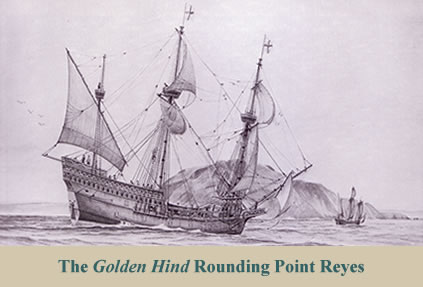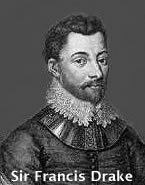
The
Drake Navigators Guild
The Drake Navigators Guild is a
non-profit research organization which brings together persons from many
fields of scholarship to study the early exploration of the west coast of
North America. Founded in 1949, its members and associates include
practical seamen and researchers in fields as diverse as nautical history,
cartography, hydrography, meteorology, ship construction, seamanship,
navigation, biology, zoology, archaeology, ethnography, museology, and
Chinese ceramics.
The Guild has identified the location of Francis
Drake's harbor of 1579, where Drake repaired his Golden Hind and made the
first English claim to the land which became the United States, as Drake's
Cove in Drakes Bay, thirty miles north of San Francisco, in the Point
Reyes National Seashore. It has also investigated Manila galleon contacts
with the coast, including the 1595 shipwreck of Sebastian Rodriguez
Cermeno's San Agustin at Drakes Bay. Recently, the Guild published the
behind-thescenes story of the Drake Plate of Brass hoax in California
History magazine's Volume 81, Number 2, 2002.
The Guild's work is
most easily accessible in its eighty-page book, Discovering Francis
Drake's California Harbor. The book tells the story of Drake's voyage
`round the world and his visit to California, as well as the story of the
fifty years of research that established the location of his activities on
this coast. The book's bibliography lists the Guild's specialized
monographs that give the details of the research. The book is available
for $13 in U.S. funds, postage included, from the address given
below.
The Guild may be contacted at the address of its present
president: Edward Von der Porten, 143 Springfield Drive, San Francisco, CA
94132-1456;
e-mail: mailto:EdandSaryl@aol.com.
History of the Drake Navigators Guild
The Drake Navigators
Guild was formed in 1949 by a small group of professional men with
nautical backgrounds. It is a non-profit organization which has the
purpose of identifying the exact location of the campsite where Francis
Drake spent thirty-six days repairing his leaking ship, seeing to the
welfare of his men, and preparing for the long voyage across the Pacific
Ocean and on to England. It also does research related to other early
explorers of the Pacific Coast of North America.
The Guild
membership through the years has included numerous sailor-scholars,
including naval and merchant marine officers Captain Raymond Aker,
Lieutenant Commander F. Richard Brace, Admiral Sir Simon Cassels,
Lieutenant Matthew P. Dillingham, Captain Daniel Dillon, Rear Admiral
Samuel Eliot Morison, Fleet Admiral Chester W. Nimitz, and Captain Adolph
S. Oko. To this strong maritime base the Guild added specialists in
nautical history, cartography, hydrography, meteorology, ship
construction, seamanship, navigation, biology, zoology, archaeology,
ethnography, museology, and Chinese ceramics. Throughout its history, the
Guild opened its work to numerous scholars from around the
world.
When the Guild began its search, the region of Drake's
landing had long been established through the work of
hydrographer-historian George Davidson of the U.S. Coast Survey in the
late nineteenth century. In 1886 Drakes Bay was officially named by the
Survey based on Davidson's work, and the designation was reaffirmed by the
Chief Geographer of the National Oceanic and Atmospheric Administration,
the successor to the Coast Survey, in 1994. That designation has appeared
on official charts, maps, and coast pilots for more than a century.
However, the exact location of Drake's camp at Drakes Bay had not been
established.
In 1952, the Guild's Matthew Dillingham located the
site of Drake's inner harbor and encampment. In the succeeding years,
Guild members conducted many types of research related to that location
and the background to Drake's visit to our shores. A bibliography of the
key documents published by the Guild has been published in Discovering
Drake's California Harbor, available from the Guild.
The Guild
Drakes's Life
Drake's Portrait
Circumnavigation
California Landings
Guild Booklet
Press Release
Publications

Copyright © DNG
2003-2016
- Updated: 23 May 2016
